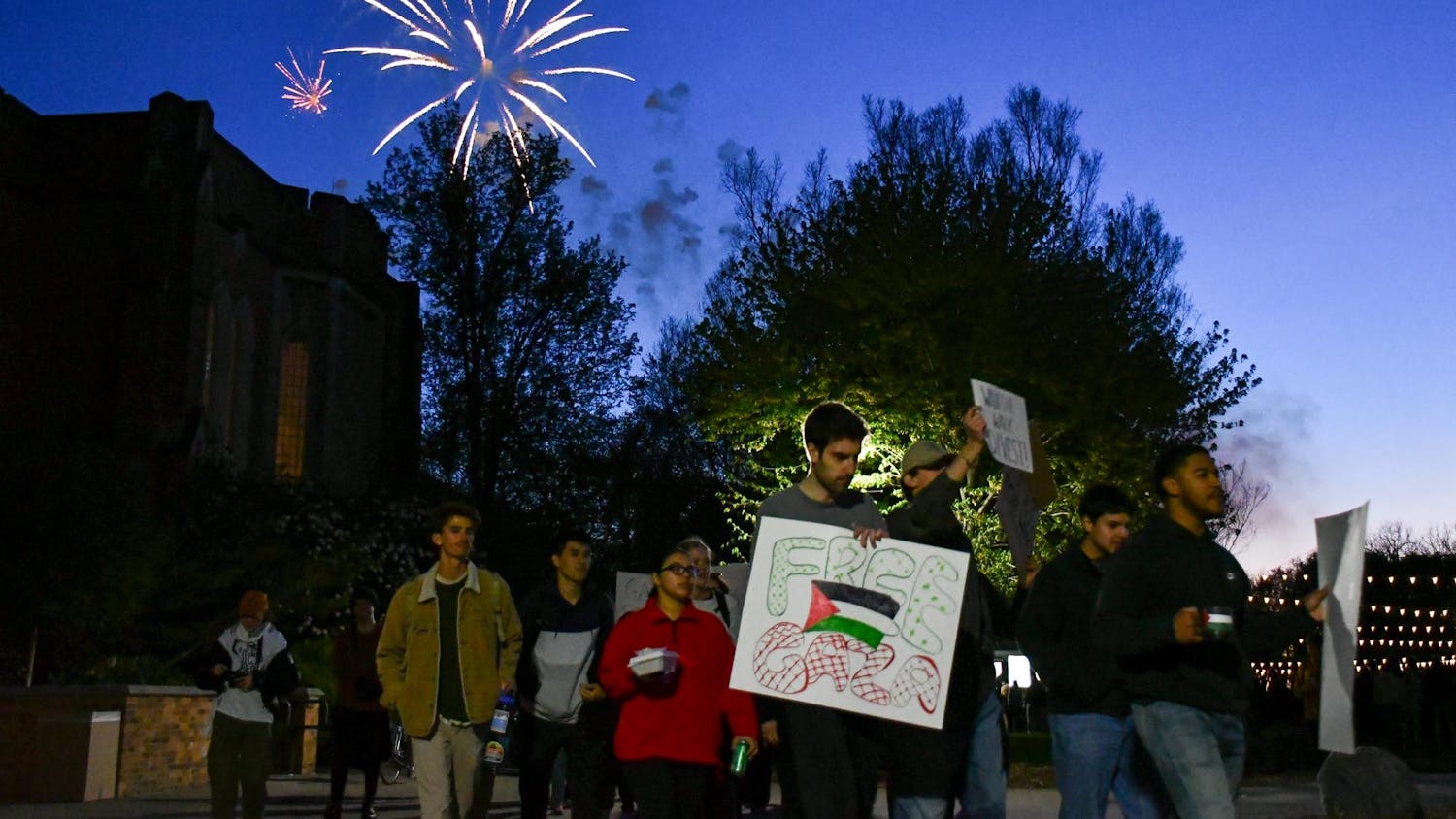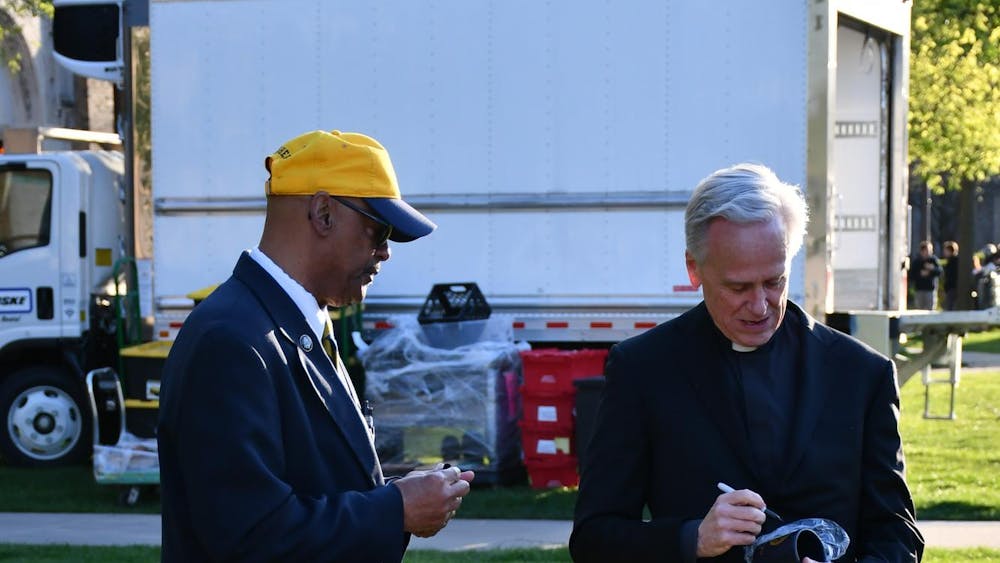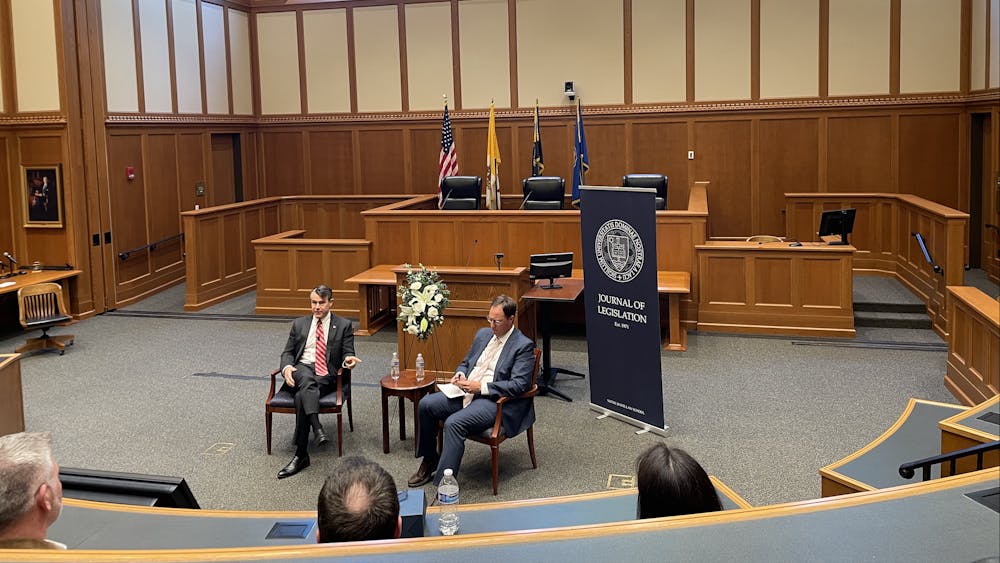Political scientist, writer and libertarian Charles Murray spoke at McKenna Hall on Tuesday afternoon on the themes in his book “Coming Apart: The State of White America, 1960-2010.”
The event was sponsored by the undergraduate minor in constitutional studies, and professor of political science Vincent Munoz opened the event by stating the purpose of inviting Murray to Notre Dame, as Murray is widely considered to be a controversial figure after co-writing “The Bell Curve” in 1994, which argues that genetics at least partly determines economic and social success.
“The University believes in the pursuit of truth and the protection of freedom of speech,” Munoz said. “Please know that the event is meant to further the purposes of the constitutional studies program, [which is] thoughtful dialogue in which people of good will listen to one another.”
Murray holds degrees from both the Massachusetts Institute of Technology and Harvard. Within his first seconds of speaking at the podium in McKenna Hall, four people in the audience stood up and walked out together.
Murray started his lecture by sharing his ideas on the forces that gave rise to the unexpected victory of Trump.
“You have a working class — especially a white working class — that exhibited last year both a great deal of anger and … a great deal of demoralization,” he said. “On the other side, you had in this case a democratic elite … an elite that is isolated and that also exhibits a certain amount of disdain from mainstream America.”
Regarding the white working class, Murray cited it as something that “seemed to be an unmitigated good.” He said in the 1950s there was a revolution in the way colleges recruited students.
“Elite colleges started to reach out to much greater parts of America and draw in students who had not been drawn in before purely on their academic ability,” Murray said. “This is a good thing.”
Murray used his alma mater, Harvard, as an example, and said in 1952 the average SAT verbal score was 583 and in 1960 it was 678.
“In non-statistical terms, what it means is that Harvard went from a place with a lot of rich kids, some of whom were smart, to being a place who had very many very smart kids, some of whom were rich,” he said.
Murray said when you bring a bunch of people with very high IQs together they “form a critical mass.” Because of this, he said, the value of brains in the marketplace skyrocketed.
“You not only had a situation in which the higher education establishment over the last half of the 20th century, those people upon leaving were making lots more money,” he said. “The combination of money and spatial concentration produced a new upper-class culture.”
Murray said the new upper class came with the inception of a new “bubble,” a new upper-class culture that was distinct from the rest of “mainstream America.” In an effort to help his readers determine whether or not they existed in this bubble, he created the “Bubble Quiz,” which consisted of 45 items and was scored from zero to 100 points. The fewer the points a person scored, the thicker the new upper-class bubble they lived in.
The quiz contained questions related to the demographics of the neighborhood one lived in, if they had ever lived below the poverty line, the types of jobs they held in the past and more. Murray said he collected 140,000 scores, along with the zip codes people lived in now and the zip codes of where they lived when they were 10. He said he found a correlation between participants’ scores on the bubble quiz and the socioeconomic status of their zip code at age 10.
Murray said the election was the end of America as a “creedal country,” creedal referring to the fact that America had a creed that was universally held.
“Egalitarianism in the sense that Americans were not supposed to get too big for their britches,” he said. “Americans were not supposed to think they were better than other people just because they had more money.
“What the election of 2016 revealed … is that those … democrats — after they came over to the right — were not absorbing the ideals of limited governments and the American creed. They had pretty much dropped out of those, too, [and] they were joining the right largely because they were so irritated with the people on the left.”
The rich and powerful tend to be clustered in the same areas, specifically New York, Los Angeles, Washington D.C. and Silicon Valley, Murray said. However, he said, a better way of living would be to “be in the midst of other people who are dealing with the stuff of life.” He said one should not live in a wealthy area just because they can, but rather, to strive to find a neighborhood that is not filled with all like-minded people.
“So I guess what I’m saying to you who, many of you will become a part of this new upper class, don’t forget that option,” He said. “To live in touch with people who are engaged with the stuff of life in a very traditional American way and maybe you, too, will love it.”
Professor of anthropology Agustin Fuentes delivered the response to Murray, as well as his own critiques on “Coming Apart.” He said while he agrees with Murray’s points on inequality having increased dramatically and social and spatial differences between classes growing farther and faster, he notes some fallacies in Murray’s book, specifically the flaws in what Murray describes as the “American Project.”
“The American Project that Mr. Murray outlines is one where the continuing effort begun with the founding of the U.S. to demonstrate that human beings can be left as individuals and families to live their lives as they see fit,” Fuentes said. “Not everyone from the very founding — and in fact most — were not left free as individuals and families to live their lives.”
As examples, Fuentes cited slavery, voting rights and women’s rights as barricades of freedom. From the founding, he said, the American Project failed from the get-go.
Fuentes then refuted Murphy’s claim that people grouped by gender, ethnicity, age, social class and sexual preference will produce group differences in outcome due to cognitive, psychological and behavioral genetic differences.
“The reductionist determinism, the almost apartheid-esque concept underlying Murray’s positions has no support with biological and anthropological sciences,” he said. “In fact, it runs counter to the rich and diverse bodies of scholarship, and yet, Murray seems to think — or rather hope — that the differences at the end of the day are deep-rooted in our human natures and reflect cognitive hierarchies rooted in our biology.
“He is wrong. The American Project Murray pines for nostalgically, and with interesting stories, is not a reality. And it never was.”
In order to deal with increased inequality and injustice in America, Fuentes said, one must not rely on false assumptions or assertions.
“It must be about trying to work with real science and the real complexities of history, and inequity combatting ignorance and bias and seeing what we as a diverse, complex and occasionally justice-seeking nation have done and can actually do,” he said. “The assumptions and assertions underlying ‘Coming Apart,’ despite the quaint stories you just heard, are unsupported, unscientific, simplistic, myopic, gender-driven propaganda and we cannot take them seriously.”
After Fuentes’ response, the event concluded with a question and answer session where the audience could send their questions in electronically. Senior Candace Thomas asked Murray about his thoughts on white privilege and whether or not he thought white people were born with advantages in life.
“Depends on what white people you are talking about,” he said. “You’d have a hard time going down the road to rural Indiana towns in the south and going there, talking to white folks there and convincing them that they are privileged. So, do I think that there is such a thing as being white in this country independent of all other factors is this privilege thing? No, not really.”
Murray then addressed another question on why the new upper class was overwhelmingly liberal. He said there was an orthodoxy on campuses and that for most of the 20th century it was tilted left, but that it has recently gotten more pronounced.
“What we are in the process of seeing now is the simultaneous strength and increasing adamancy of the orthodoxy of the social sciences at the same time that what is going on in the hard sciences will — in another 10 or 15 years — will have finished off the story in the following sentence,” he said.
Murray said that story will not be revolutionary, and that the differences between men, women and ethnic groups will have a genetic component.
“This will not be earthshaking,” he said. “In most cases it will be a validation of what most of us look around and see and take for granted and are not particularly bothered by. But, it will be a revolution in the social sciences.
“So that I would say by 2025 to 2030 if you are a sociologist and you publish an article trying to explain the probability of being arrested by age 21 on the basis of the standard socioeconomic set of independent variables, that you will not be able to get it published anymore unless you’ve also incorporated what’s been going on in the hard sciences. This revolution is coming down the road.”
At this point, Fuentes stood up to protest this claim, but Murray addressed him and said he just wanted to finish his sentence, and then he would give the floor to Fuentes.
“I will say that when I hear the kinds of things you are saying about the state of knowledge on these fields that you are the one living in Never-Neverland,” Murray said to Fuentes.
Fuentes responded by addressing the audience and said there was “an incredible body of data out there.”
“Don’t take my word. Don’t take his word. Do the reading,” Fuentes said. “Look at the entire body, sociological, anthropological, population genetic, cognitive science literature. It is there, it is prominent. We have been researching this for over a century and it is clear.”













